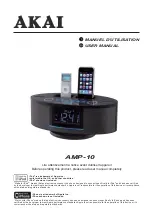
19
G. Screen Losses:
Through-the-screen losses are complex to analyze in detail. The on-axis loss is approximately a 6 dB/
octave rolloff commencing at about 5 kHz. However, off-axis response is quite different. At certain angles, high
frequencies are transmitted through the screen with relatively little loss. When an on-axis HF boost is applied to
the signal for proper system response on-axis, patrons seated toward the sides (off-axis) will hear more HF than
those listeners on-axis. This, coupled with the normal off-axis fall-off of the horn’s response, tends to maintain a
good balance of high and mid frequency program and enables patrons seated to the sides to enjoy good dialog
intelligibility. The patented technology of Screen Spreading Compensation in the JBL ScreenArray models
compensate for the high frequency energy loss of screen.
From a design viewpoint, the engineer must ensure that there is adequate electrical headroom in the
high frequency drivers to attain flat power response above 3 kHz. This usually requires that the signal be boosted
6 dB/octave above 3 kHz, and this requires that the drive level at 12 kHz will be 10 to 12 dB greater than at mid
frequencies. A driver must be specified that can handle this increased input — and at the same time be able to
provide a good match with the low frequency system. All JBL cinema systems have been engineered with this
requirement in mind.
In mid-size screening rooms there is less air loss to deal with, and it is often the case that no more than
a 10 dB boost is required to meet the equalization requirements above 10 kHz. Many conservative engineers feel
that a 10 dB boost should never be exceeded.
H. JBL’s New ScreenArray Loudspeaker Systems:
The ScreenArray series consists of two new 2-way and two new 3-way systems that bring significant
improvements to mid-size cinemas and embody the following characteristics:
1. Shallow design. Intended for use in theaters with limited space behind the screen
2. Low distortion high frequency section using Progressive Transition
™
Waveguides
3. SSC™ Screen Spreading Compensation to take advantage of the screen’s transmission
characteristics in maintaining uniform high frequency coverage throughout the cinema
4. Focused Coverage Technology™ to maintain absolutely uniform midrange coverage in
the cinema
Figure 26A and B show front and side views of the model 4632. This model is intended for use in cinemas
seating up to 500 patrons. Figure 26C and D show front and side views of the model 3632, which is intended for
use in cinemas seating up to 300 patrons.
The remarkable axial frequency response, beamwidth and directivity of the 4632 are shown in
Figure 27A, B and C. Equivalent data for the 3632 are shown in Figure 27D, E and F.
The model 3632 and 4632 must be operated in biamped mode. The 3632T and 4632T are operated in
triamped mode for THX
®
certified installations.
















































